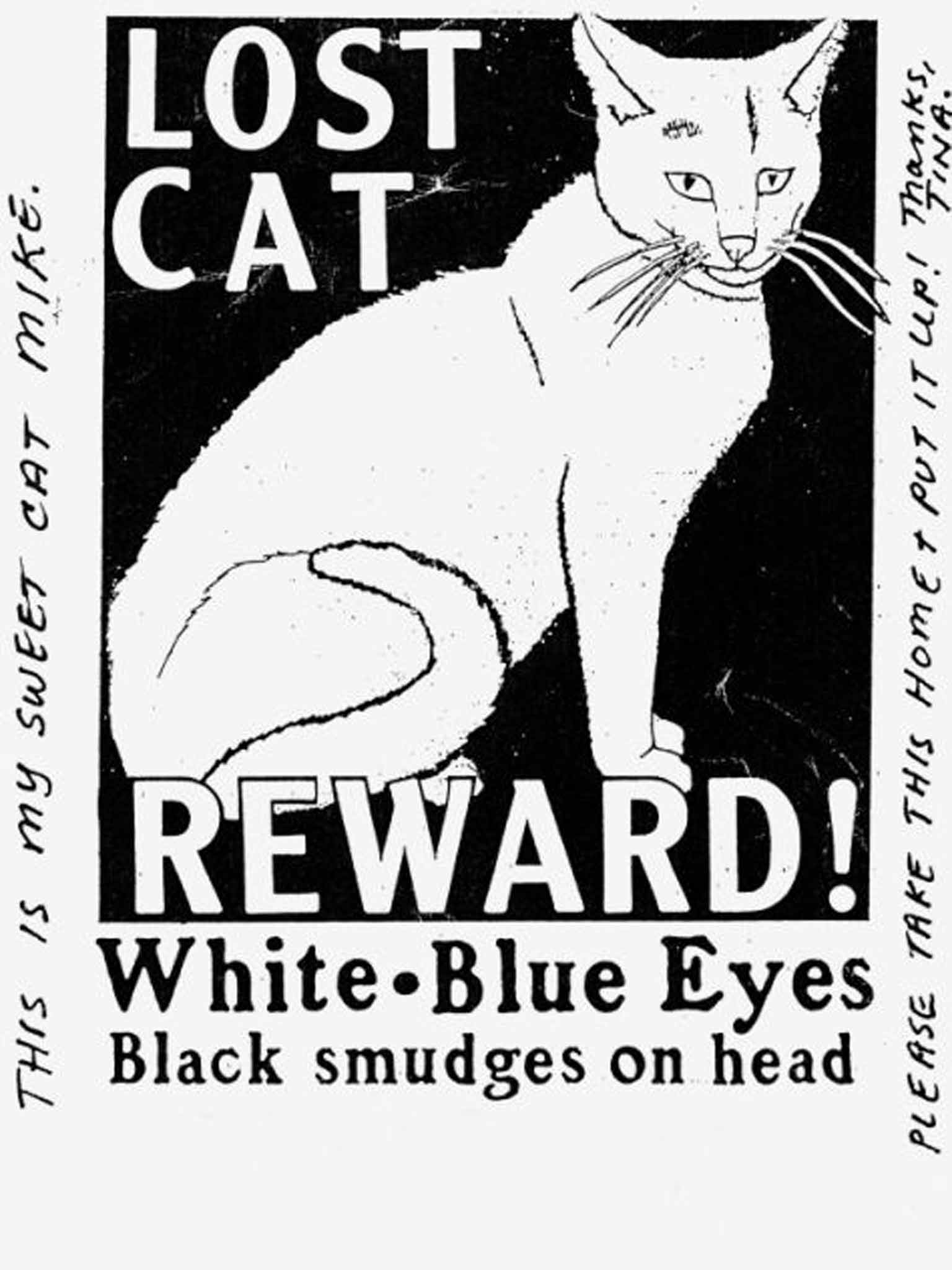Lost pets posters: The photocopied picture of a much-missed companion is not a thing of the past
Fifteen years ago, artist Ian Phillips published a collection of missing-pet posters from around the world. As a new edition is released, Rebecca Armstrong explores their appeal

On a street near my house recently, I spotted what I thought were three missing cat posters. I find these kinds of notices desperately sad, especially when they are rain-stained and blurry, with the creature pictured unrecognisable (Dog? Cat? Rodent of unusual size?). "Do you know this cat?" read the first. Accompanying the animal's description (green eyes, large, black fur) was a child's drawing of a cat. Gulp.
"The ones drawn by little kids are especially heartbreaking," says Ian Phillips, creator of the book Lost: Lost and Found Pet Posters from Around the World, the 15th anniversary edition of which is published this week. Phillips's collection of lost-pet posters began when the American artist was living in Switzerland. His room-mate's cat went missing and was only found after a neighbourhood poster campaign. Intrigued, Phillips decided to discover whether the missing-pet poster was universal, and tracked them down from different parts of the world, via friends, family, artists and penpals.
He received examples from Australia, Japan, Europe and the US, and turned his favourite examples of what he calls "correspondence art" into the book. "After the original publication, I was inundated with posters," says Phillips. "People were mailing them to me from all over." But things changed. "It dwindled to one a month and eventually they just stopped altogether. I think that that network of people who did that disappeared with the advent of the internet." So, with the ubiquity of microchips and search parties now organised on social media, is the forlorn photocopy bearing a picture of a much-missed companion a thing of the past? My recent experience suggests not.
Lost pets posters
Show all 8"Every now and then I hear a happy ending to the little stories that the posters tell," says Phillips. "The other day, I was talking to a friend of mine whose cat went missing and she put posters around the neighbourhood. She got a call saying that the cat had been hit by a car and killed."
This doesn't sound very happy to me. "It was a case of mistaken identity – it wasn't her cat. A couple of days later, she was walking by a garage and she could see a little paw poking out from under the door. Her cat had been locked in a neighbour's garage and so she went and knocked on their door and got it back."
As a connoisseur of long standing, what conclusions has Phillips drawn about the state of the pet poster? "The posters that use a sense of humour are mostly the cat posters. I think that's because when people's cats go missing, cats are better at taking care of themselves than dogs are. Cats watch for cars, and dogs don't, and I think that people think that their cats are off on an adventure somewhere." (A poster from Wisconsin with the image of a cat with a speech bubble above its head that reads "Where the hell am I?" goes some way to prove his theory).
But the desire to get laughs is, he thinks, the reason why so many missing-pet posters that appear in online galleries aren't what they seem. "Quite often you see ones on there that are obviously not real." One of my own favourite "found" notices that did the rounds on Twitter seems likely to fall into this category. "Found! Cat Snake? Found (assuming) pet. Some sort of cat snake? Long and nimble but with dryish fur and cat teeth. Seems to like cat food, but isn't a cat. Please come take this off my hands, it smells weird." This ran alongside a photograph of what was unmistakeably a ferret.
For Phillips, the posters have to be real to be of note. But hasn't he taken advantage of people's misfortune in creating his book? Or was it a case of exploring how people put forward their emotions in paper form? "I think it was a bit of both. I think that the posters are art, I just brought people's attention to that," he says.
As for the three posters that appeared in my neighbourhood, they turned out to be a kind of correspondence art, too. The notice that asked "Do you know this cat?" was followed by one that read, in an adult hand, "Hello, we believe you've been visited by George our cat. He sleeps most of the time but clearly found a time in his busy schedule to pay you a visit." The final message? "George is a very friendly cat. Perhaps one day he'll meet my cat Gilbert." Probably the sweetest art ever to come from Gilbert and George.
'Lost: Lost and Found Pet Posters From Around the World' by Ian Phillips (£10.99, Princeton Architectural Press) is out now
Subscribe to Independent Premium to bookmark this article
Want to bookmark your favourite articles and stories to read or reference later? Start your Independent Premium subscription today.

Join our commenting forum
Join thought-provoking conversations, follow other Independent readers and see their replies